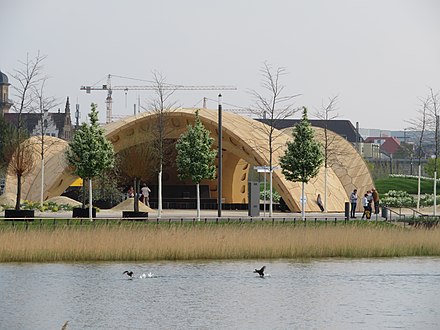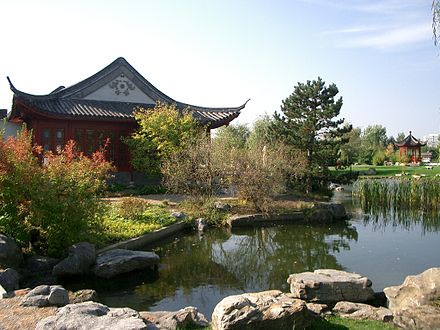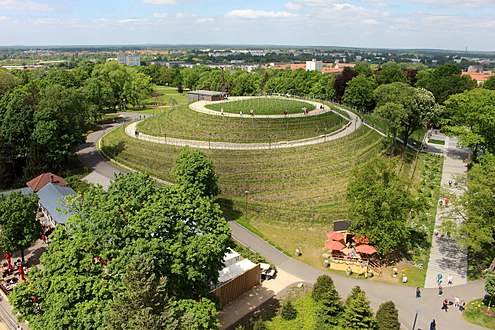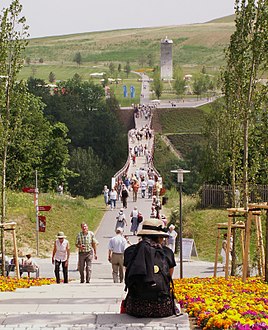Federal Garden Show
The Federal Horticultural Show ( BUGA ) is a German exhibition on horticulture that also includes topics such as landscape architecture . It takes place every two years in various German cities, every ten years as an International Horticultural Exhibition (IGA). At the same time there are state horticultural shows in the federal states.
concept
In addition to federal authorities and the organizing cities, the Deutsche Bundesgartenschau GmbH (DBG), founded in 1993, is involved today, backed by the Zentralverband Gartenbau e. V. (ZVG), the Federal Association of Gardening, Landscaping and Sports Field Construction (BGL) and the Association of German Tree Nurseries (BdB). The patronage of a federal horticultural show is taken over by the respective federal president .
As part of a federal horticultural show, extensive open space planning and redesign are taking place in the respective cities with a high budget , which serve the regional development goals. Often a completely new federal horticultural show site is created, which attracts millions of visitors over a period of several months.
In the first few decades, the federal horticultural shows mostly took place in the major metropolises of the Federal Republic. Since the mid-1990s, smaller towns with around 100,000 inhabitants have also increasingly been selected as hosts. The Federal Horticultural Show 2007 was the first BUGA to be held on two exhibition areas in two neighboring cities ( Gera and Ronneburg ). With the Federal Garden Show 2015 in Havelland, a strongly decentralized Federal Garden Show took place for the first time, spread across five locations in two federal states.
The Federal Horticultural Show has already been organized in twelve federal states, the most recent being Thuringia (2007) and Rhineland-Palatinate (2011). In the federal states of Bremen , Saarland , Saxony and Schleswig-Holstein there were no federal horticultural shows.
Federal Garden Show 2019 : Heilbronn
International garden exhibition 2017 : Berlin
Federal Horticultural Show 2015 : Havel region
International Garden Show 2013 : Hamburg
BUGA 1991: Dortmund
BUGA 1955: Kassel
history
Horticultural exhibitions have a centuries-old tradition , sometimes as a short-term opening of private gardens .
The first international agricultural and horticultural exhibition took place from September 9th to 17th, 1865 in Erfurt . On September 6, 1876, a General German Horticultural Exhibition was opened in the Augustapark of the Erfurt Steigers in the presence of Empress Augusta , which lasted until September 17, 1876. Until the First World War, several national horticultural exhibitions were held in the traditional "city of flowers".
There is evidence of an international horticultural exhibition in Dresden in 1887 , for which a Hamburg State Prize was donated due to the importance of the exhibition. The exhibition took place in the presence of Heinrich Gustav Reichenbach , a world-renowned botanist and director of the Hamburg Botanical Garden since 1863 .
In 1896 a second international horticultural exhibition was organized in Dresden , on the occasion of which the city exhibition palace was opened. In 1900 the series of exhibitions with the Great German Horticultural Exhibition was continued there because of such a tradition . Finally, in 1907, the III. International horticultural exhibition again in Dresden. In the same year, a large horticultural exhibition was also held in Mannheim .
Meanwhile, the teaching Mainzer Horticultural Association in 1901, the General German Horticultural Exposition , and in Altona followed in 1914 on the 250th anniversary of Altona and the exemption from Danish rule, the German Horticultural Exposition . The two aforementioned exhibitions were organized with significant participation by Ferdinand Tutenberg .
After the end of the First World War, three nationally oriented garden shows took place in the 1920s ( Weimar Republic ) - at the time referred to as horticultural exhibitions - with some international participation and an extremely positive response from the public:
- 1926: Anniversary horticultural exhibition in Dresden, held on the occasion of the 100th anniversary of the Dresden horticultural society " Flora " and linked to the International Art Exhibition Dresden 1926 (5th Annual Show of German Labor )
- 1927: German Horticultural and Silesian Trade Exhibition ( GUGALI ) in Liegnitz
- 1929: Large Ruhrland Horticultural Exhibition ( GRUGA ) in Essen
Reichsgartenschau

Until the beginning of the Second World War, this tradition was continued with Reichsgartenschau (official name Reichsausstellungen des German horticulture ) (hence the renewed choice of Dresden and Essen as venues):
- 1933: German Horticultural Exhibition in Berlin, in the exhibition halls on Kaiserdamm. First large horticultural hall show in Germany. Head: Gustav Allinger .
- 1933: Annual Show of German Garden Culture and Landscape Management ( JaDeGa ) from June 24th to October 10th 1933 in the expanded city hall garden in Hanover
- 1936: 1st Reich Exhibition of German Horticulture on the municipal exhibition grounds and parts of the Great Garden in Dresden from April 24 to October 11, 1936, which was briefly called the Dresden Reich Garden Show
- 1938: 2nd Reich Exhibition of German Horticulture from April 26 to October 12, 1938 as the second Reich Garden Show in Essen's Grugapark : The site is almost doubled, including a ceramic courtyard and a large flower courtyard
- 1939: 3rd Reich Exhibition of German Horticulture from April 22 to September 2, 1939 in Stuttgart as the third Reich Garden Show ; The Killesberg Park in Stuttgart goes back to this .
post war period
Today's Federal Garden Show, however, is a child of the Federal Republic's post-war history: in 1949 the Southwest German Garden Show (SÜWEGA) took place in Landau in the Palatinate , Stuttgart followed in 1950 with the German Garden Show and 1951 is the year of today's first Federal Garden Show with the 1951 Federal Garden Show in Hanover . From May to October 1952, however, a simple, 2nd Great Ruhr Land Horticultural Exhibition ( Gruga ) took place in Essen. In view of federal and state horticultural shows, Essen then no longer held a Gruga, but then organized the federal horticultural show in 1965 (see below).
The IGA in Munich reached the highest number of visitors at a BUGA in 1983 with 11.5 million visitors, of which up to 250,000 were in one day. The Federal Garden Show in Mannheim in 1975 had the second highest number of visitors to date with 8.1 million visitors and was the most successful BUGA to date. After the international horticultural exhibition in Stuttgart in 1993 , which was very successful with 7.3 million visitors , the number of visitors to the following exhibitions fell sharply. Until 2011, the number of visitors stayed below three million. It was not until the Federal Garden Show 2011 in Koblenz exceeded this mark and counted a total of 3,558,274 visitors by the end of October 16, 2011, which is the record number of visitors at a Federal Garden Show since the electronic counting system was introduced in 1997.
As a socialist alternative to the Buga or IGA, the international horticultural exhibition “iga” was created in Erfurt in 1961, and in 1991 it was converted into today's egapark . The egapark is to form the heart of the BUGA 2021 in Erfurt.
Events
| year | Period | city | park | country | comment | logo |
|---|---|---|---|---|---|---|
| 1951 | April 28th - October 31st |
Hanover | Stadtpark (city hall garden) | Lower Saxony | first and to date only federal horticultural show in Lower Saxony | |
|
1953 (IGA) |
April 30th - October 11th |
Hamburg | Planten un Blomen | Hamburg | first federal horticultural show in Hamburg | |
| 1955 | April 29th - October 16th |
kassel | Karlsaue | Hesse | first federal horticultural show in Hessen; the first documenta took place as a side program | |
| 1957 | April 29th - October 24th |
Cologne | Rheinpark | North Rhine-Westphalia | first federal horticultural show in North Rhine-Westphalia | |
| 1959 | April 30th - October 17th |
Dortmund | Westfalenpark | North Rhine-Westphalia | ||
| 1961 | April 28th - October 15th |
Stuttgart | Upper and Middle Palace Gardens , Killesberg Park |
Baden-Württemberg | first federal horticultural show in Baden-Württemberg | |
|
1963 (IGA) |
April 26th - October 13th |
Hamburg |
Planten un Blomen , (old) botanical garden , small and large ramparts |
Hamburg | ||
| 1965 | April 29th - October 17th |
eat | Grugapark | North Rhine-Westphalia | ||
| 1967 | April 14th - October 23rd |
Karlsruhe | City garden , palace garden | Baden-Württemberg | ||
| 1969 | April 25th - October 12th |
Dortmund | Westfalenpark | North Rhine-Westphalia | EUROFLOR | |
| 1971 | April 29th - October 24th |
Cologne | Rheinpark , Riehler Aue | North Rhine-Westphalia | ||
|
1973 (IGA) |
April 27th - October 7th |
Hamburg | Planten un Blomen , small and large ramparts | Hamburg | ||
| 1975 | April 18 - October 19 |
Mannheim | Luisenpark , Herzogenriedpark | Baden-Württemberg | Most successful BUGA to date with 8.1 million visitors | |
| 1977 | April 29th - October 23rd |
Stuttgart | Lower palace garden | Baden-Württemberg |
|
|
| 1979 | April 27th - October 21st |
Bonn | Rheinaue | North Rhine-Westphalia | ||
| 1981 | April 30th - October 18th |
kassel | Fuldaaue , Karlsaue | Hesse | ||
|
1983 (IGA) |
April 28th - October 9th |
Munich | Westpark (Mollgelände) | Bavaria | first federal horticultural show in Bavaria; approx. 11.5 million visitors, including over 250,000 on peak days; Most popular Federal Horticultural Show |

|
| 1985 | April 26th - October 20th |
Berlin | Britz garden | Berlin | first Federal Horticultural Show in Berlin | |
| 1987 | April 30th - October 11th |
Dusseldorf | Volksgarten , south park | North Rhine-Westphalia | ||
| 1989 | April 21st - October 15th |
Frankfurt | Niddapark | Hesse |

|
|
| 1991 | April 26th - October 20th |
Dortmund | Westfalenpark | North Rhine-Westphalia | ||
|
1993 (IGA) |
April 23rd - October 17th |
Stuttgart |
Green U ( Höhenpark Killesberg , Wartberg , Leibfriedscher Garten , Rosensteinpark ) |
Baden-Württemberg | ||
| 1995 | April 29th - October 8th |
cottbus | Elias - and Spreeauenpark | Brandenburg | first federal horticultural show in Brandenburg and in the new federal states; Cottbus only stepped in as an organizer in 1993 after Berlin's cancellation |

|
| 1997 | April 19 - October 5 |
Gelsenkirchen | North Star Park | North Rhine-Westphalia | first federal horticultural show on a former coal industry site | |
| 1999 | April 23rd - October 17th |
Magdeburg | Elbauenpark | Saxony-Anhalt | first federal horticultural show in Saxony-Anhalt | |
| 2001 | April 21st - October 7th |
Potsdam | Volkspark (Bornstedter Feld) | Brandenburg | The main attractions included the motifs "Places on the River", "Historic City Center", "Feldflur" and " Biosphere Potsdam " |
|
|
2003 (IGA) |
April 25th - October 12th |
Rostock | IGA park | Mecklenburg-Western Pomerania | first federal horticultural show in Mecklenburg-Western Pomerania |

|
| 2005 | April 28th - October 9th |
Munich | Riemer Park | Bavaria |

|
|
| 2007 | April 27th - October 14th |
Gera , Ronneburg |
Hofwiesenpark , New Landscape Ronneburg |
Thuringia | first federal horticultural show in Thuringia and first in two cities |

|
| 2009 | April 23 - October 11 |
Schwerin | Downtown, around the castle | Mecklenburg-Western Pomerania |

|
|
| 2011 | April 15 - October 16 |
Koblenz | Three core areas: Blumenhof at the Deutsches Eck , Electoral Palace and Ehrenbreitstein Fortress |
Rhineland-Palatinate | first federal horticultural show in Rhineland-Palatinate |

|
|
2013 (IGS) |
April 26th - October 13th |
Hamburg | Elbe island Wilhelmsburg with Georgswerder | Hamburg |

|
|
| 2015 | April 18 - October 11 |
Havel region → Brandenburg → Rathenow → Premnitz → Stölln → Havelberg |
Brandenburg, Saxony-Anhalt |
highly decentralized; first transnational federal horticultural show |

|
|
|
2017 (IGA) |
April 13th - October 15th |
Berlin | " Gardens of the World ", expansion areas and parts of the Wuhletal | Berlin | As a test project, the first garden show, the sustainability of which was certified according to the FLL guidelines for sustainable outdoor areas | |
| 2019 | April 17th - October 6th |
Heilbronn | Neckar bend | Baden-Württemberg | first federal horticultural show with city exhibition |
|
| 2021 | April 23 - October 10 | Erfurt | egapark , Petersberg , Gera-Aue (from Nordpark to Kilianipark) | Thuringia | at the same time the 60th anniversary of the egapark, where the first international horticultural exhibition of socialist countries took place in 1961 | |
| 2023 | April 20 - October 23 | Mannheim | Conversion site “Spinelli Barracks”, Feudenheimer Au | Baden-Württemberg | ||
| 2025 | Rostock | City harbor and Warnowufer | Mecklenburg-Western Pomerania | |||
|
2027 (IGA) |
Ruhr area | North Rhine-Westphalia | decentralized | |||
| 2029 | World Heritage cultural landscape of the Upper Middle Rhine Valley | Koblenz to Bingen / Rüdesheim | Rhineland-Palatinate | highly decentralized | ||
Criticism of garden shows from 1980
“Garden shows” are performance shows of the horticultural industry and its associations co-financed with tax revenues. They should serve as a tourist attraction and attract visitors to the host cities. As early as 1980, in view of the Federal Garden Show in Kassel in 1981, the German Werkbund published the brochure Destroyed by Care , which showed in detail how the historic Karlsaue in Kassel was prepared, damaged and disfigured for the show. The sociologist and economist Lucius Burckhardt already called for a rethink at that time: “After the Second World War”, he argued, “garden shows helped restore the parks to their parks or repair them”, but now there are hardly any “open spaces close to cities, that can be transformed into parks ”, the result is that“ parks that were once usable are too richly orchestrated and therefore transformed into parks that can only be viewed ”.
In the course of the preparations for the igs 2013 in Hamburg-Wilhelmsburg, almost 2500 trees were felled and more than 4000 meters of hedge vegetation removed, according to a report by the "Harburg Ads and News". A 2860 square meter wet meadow was also drained to create a noise protection wall. Hamburg spent a total of 70 million euros on igs. Nature was also permanently destroyed for the construction of 2500 parking spaces, which were only used during the garden show. And even the compensatory measures in the east of the Elbe island once again destroyed intact biotopes, as wetlands and meadows there were redesigned to make room for tree planting.
See also
Web links
Individual evidence
- ↑ Even the French Sun King Louis XIV himself wrote a guide through the palace gardens of Versailles; see: Simone Hoog, Daniel Meyer: Versailles - The Great Art Guide , p. 126. In German-speaking countries, for example, under Elector Karl Theodor, the park of Schwetzingen Palace was partially open to the public. At the entrance to the Great Garden in Hanover-Herrenhausen , the park rules, carved in stone, still hang today, on which it can be read: "Everyone is allowed to make a change in the royal garden".
- ↑ Jürgen Zerrull: Development of the Erfurt garden shows. A demolition. In: Martin Baumann, Steffen Raßloff (eds.): City of flowers Erfurt. Waid - Horticulture - iga / egapark. Erfurt 2011, pp. 208–222
- ↑ Hamburger Staatsarchiv, Findbuch Volume 4, p. 436
- ^ Heinrich Gustav Reichenbach (1823-1889) , orchids.co.in
- ↑ a b Hamburger Staatsarchiv, Findbuch Volume 4, p. 437
- ↑ Hamburger Staatsarchiv, Findbuch Volume 4, p. 441
- ^ City of Mannheim, Michael Caroli, Ulrich Nieß (eds.): History of the city of Mannheim: Vol. 2 1801-1914. Ubstadt-Weiher 2008, ISBN 978-3-89735-471-5 .
- ↑ Hamburger Staatsarchiv, Findbuch Volume 4, p. 473
- ^ Official catalog for the […] General German Horticultural Exhibition, organizer. by the Mainz Horticultural Association , Mainz. ZDB ID: 2191696-2.
- ↑ Page on the rose garden in the Altona city park ( memento from July 14, 2012 in the web archive archive.today ), website of the landscape architect J. Schnitter
- ^ Gustav Allinger: Exhibition garden German Horticultural Exhibition Berlin 1933 , Technical University Berlin, architecture museum in the university library
- ^ Federal Garden Show and Flower Parade , cultural archive at the FH Hannover
- ↑ Stuttgart Exhibition GmbH (Ed.): German Garden Show Stuttgart 1950. Plan and guide . Stuttgart 1950.
- ↑ a b Number of visitors to the Federal Garden Show and the International Garden Show from 1951 to 2013 (in millions). In: statista. Accessed February 9, 2014 (fee required).
- ↑ a b City of Munich - Building Department: 20 Years Westpark - A landscape to breathe easily . Munich 2005. Chapter planning and first construction phase , pp. 10–15
- ↑ a b City of Mannheim, Michael Caroli, Ulrich Nieß (ed.): History of the City of Mannheim, Volume 3: 1914–2007. Ubstadt-Weiher 2009, ISBN 978-3-89735-472-2 .
- ^ IGA Stuttgart 1993 ( Memento from March 7, 2014 in the Internet Archive )
- ↑ BUGA Koblenz 2011. In: Bundesgartenschau.de. Retrieved February 9, 2014 .
- ↑ The Buga should have a long lasting effect in: Rhein-Zeitung , October 17, 2011
- ^ Page on the Federal Garden Show in Potsdam
- ↑ FLL - Forschungsgesellschaft Landschaftsentwicklung Landschaftsbau e. V.
- ^ Kassels Karlsaue - destroyed by maintenance , in: Lotus International, No. 31, 1981
- ↑ The sacrificial garden - nature in Wilhelmsburg needs 25 years to recover from the garden show ( Memento from February 20, 2013 in the Internet Archive ) , HAN, March 20, 2012, p. 3 (retrieved from Internet Archive)
- ↑ Elbe island nature will only recover in 25 years - around 2000 trees were cut down in Wilhelmsburg. Member of Parliament criticizes compensatory measures , Hamburger Abendblatt, March 21, 2012







